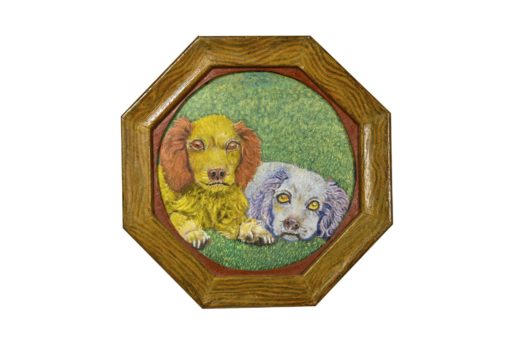Prince and Princess – Wyers
La Betty was thrilled to read the description of a royal commemorative platter. The portrait of the prince and princess beguiled La Betty into a swoon. The enchanting illustration was well detailed, as one would expect from a magazine that cost fifty dollars. The illustration revived memories of all the glamorous photographs that had captivated La Betty over the years. The portraits on the plate were shining just as the prince and princess shone together when the two of them had believed in their romance. The princess was radiantly beautiful, or perhaps radiantly photogenic, but flat glossy photos were just what La Betty preferred. The platter pictured early days when the prince’s hair was thick and dark, short of course, befitting a navy officer. The prince wore a dark, rather too ample suit, a white shirt and a droopy black bow tie. The prince was lanky and his posture was well balanced, unlike his aging father, a consort who’d spent his entire life leaning forward at the waist with his hands clasped behind his back.
The princess was wearing a long white raw silk gown. The formfitting bodice was of the same fabric yet with the faintest tinge of rose, leaving ample room above the bosom for a delicate gold chain graced by three little emeralds and twenty-four tiny pearls. The long white sleeves were the same material as the skirt, embroidered with miniscule yellow roses and hundreds of over-sized pink thorns. The ad copy alongside the picture included guarantees that the background – the bottom of the commemorative platter -- was cream white enhanced by a grid fine-lined in gold.
The closer La Betty looked, however, the more incongruous the image and the advertising copy became. Inexplicably the text failed to mention a prominent silver inscription that encircled the plate’s Prussian blue border:
rex vir bonus habeat bonam in hunc modum canis. [A good king is as loyal as a good dog.]
La Betty couldn’t remember ever seeing a photograph of the prince with such a ruddy complexion. His nose, as was traditional in the royal family, looked very narrow, long and pointed but here it was reddish brown, and the flared nostrils surprisingly large. La Betty held the magazine at different angles to check whether it was the lighting in her condo’s reading room that accounted for the colour of the prince’s huge round eyes. The eyes were as orange as pumpkins. La Betty was offended that the prince had let his fingernails grow too long. The nails were bone white and slightly curled back toward the palm. Now La Betty became wary of the princess’ image. She expected travesty.
Now the head of the princess was set askew and strangely dissociated from the foreground. Her hair was bushy and gray with pink highlights. The eyes were round and perverse, like pools of butterscotch pudding.
It was happening once again, this time within the lavish magazine page. La Betty’s solitude was being infiltrated by malevolent spirits. La Betty’s leisure was being invaded by nefarious fiends. These phantasms were rearranging the perspective. These nasty twentieth century apparitions intended to obstruct La Betty’s absorption into the new century of the Spectacle.
La Betty heard a whispering sound, like pages turning. The rapidly swishing pages were like voices on the wind, “You have many toys but you never play. Most of your toys do nothing. Let us move in. You needn’t ever shop again.”
La Betty quickly fortified her disdain with a slogan, ‘”Stop Time. Stay Young. Stop Time. Stay Young.” She also intoned the product’s name “24-carat gold, royal jelly Crème Imperial moisturizer,” and glanced again at the platter. The figure labeled “prince” and the pinkish-gray one labeled “princess” were Spaniels.
La Betty stood up straight. She thrust the magazine against her reading room’s ammonite gray enameled-lava floor. She kicked away her baby harp seal fur slippers and reached for a nearby pitcher of Danziger Goldwasser. She doused the magazine fiercely, and then marched boldly toward her prized 1953 metal Friso Kramer bookcase. La Betty reached for a prominent leather bound sheaf of paper. This odd artist’s book was hexagonal and the russet leather had been stained to look like wood. Still indignant, La Betty snatched out one of the loose-leaf pages. La Betty stood there loudly reading,
All the world’s a shop, And we are but customers in it. We have our entrances and exits; The best of us have many styles and money enough to obey our fancies.
